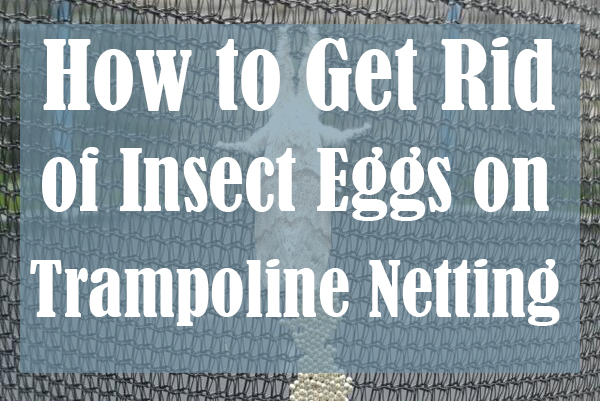
How to Get Rid of Insect Eggs on Trampoline Netting
For most of us, some of the best childhood memories involve a giant trampoline resting in our or our friend’s backyard.
It was always incredibly fun jumping on a trampoline with our friends. In fact, we wouldn’t be surprised to find bruise marks on our skin for landing so hard on the ground.
Back then, we neither had safety padding nor netting around the mat. But today, we can’t even imagine a trampoline without a safety net for our children.
However, trampoline nets are exposed to insect eggs, debris, and messy hands, which make them quite dirty.
If you’re a new trampoline owner, you might not know how to clean the net. But it’s really important to keep the trampoline clean – firstly, for your children’s hygiene and secondly, if you want to extend the lifespan of it.
How Long Does a Trampoline Last?

Taking extra care of your trampoline can increase its lifespan. Of course, with time, you would need to replace certain parts.
Generally, safety pads last for 3 to 5 years, while the mat lasts for around 5 to 6 years.
As silly as it may sound, your purchase can last for many years if you maintain it properly. An early replacement of the net, which can last up to 4 to 5 years, can be avoided if you know how to keep it clean.
How to Clean the Trampoline Netting

Usually, there are two steps involved:
- 1. Identify the eggs
- 2. Get rid of those eggs
Step 1: Identify the Eggs
Normally, the trampolines are kept out in the backyard rather than indoors. So there are high chances of finding eggs on trampoline netting.
The sooner you notice them, the better. Consider all kinds of small, round eggs on the trampoline net as a warning sign and remove them immediately.
If you see a silk woven sack on the net, it’s probably a spider egg. You shouldn’t panic, as spiders are mostly harmless, except for a few venomous spiders found in the U.S.
On the other hand, moths are pests that can destroy fabric and other materials. Moth eggs are milky white and are so small that they could be easily missed.
So before those insects eat your fabric, the easiest solution is to get rid of them completely. And that brings us to our next step.
Step 2: Get Rid of Those Eggs

(I) Remove the Net and Wash It
The safety net is there to protect our kids from falling and hurting themselves.
The good thing is that it is easy to detach it from the frame. You can take the whole net down and clean it by hand using soapy water.
- Wash in warm water with a ratio of approximately 1 part detergent to 30 parts water
- Soak the net for 12-15 minutes and toss it with your hands. The eggs will fall off
- Empty the detergent and re-rinse it in more warm water until the water runs clear
- Gently press on the towel to soak up excess water
- Hang the netting on a clothesline to dry, and make sure to hang it appropriately so that it doesn't crease.
(ii) Use Organic Spray
An organic spray, or a natural insecticide, should be only used as a last resort.
It kills insect eggs, but you might still find the dead eggs hanging on the net. In that case, you can still easily remove them with a water spray or using your hands.
We suggest that you use a solution of neem oil. It can be very effective on caterpillars, moths, whiteflies, and similar insect eggs found on trampoline netting. Still, make sure to always wear your rubber gloves, long sleeves, and a face mask before spraying.
Conclusion
It’s true that prevention is always better than cure.
We understand that the trampoline net can accumulate a great amount of dust over time; it easily captures the debris, including the eggs, and it regularly comes in contact with our hands and feet.
When the trampoline is not in use, it’s always better to keep it covered. Get a good-quality trampoline cover so that the next time your kids want to use the trampoline, they don’t have to worry about finding any debris stuck on it.
That’s it. If you found this article useful, don’t forget to share it with your friends and family. You can do so by using the sharing icons. Also, if there’s any other trick that has worked for you previously, don’t hesitate to comment below.

